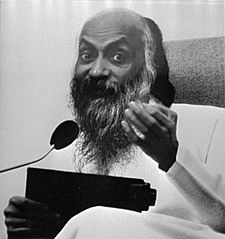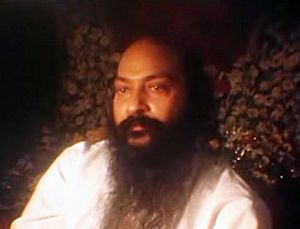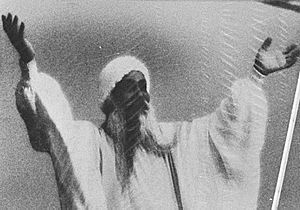Rajneesh facts for kids
Quick facts for kids
Rajneesh
|
|
|---|---|

Rajneesh in 1981
|
|
| Born |
Chandra Mohan Jain
11 December 1931 Kuchwada, Bhopal State, British India
|
| Died | 19 January 1990 (aged 58) Pune, Maharashtra, India
|
| Education | University of Sagar (MA) |
| Known for | Spirituality, mysticism, anti-religion |
| Movement | Neo-sannyasins |
| Memorial(s) | Osho International Meditation Resort, Pune |
Rajneesh (born Chandra Mohan Jain; 11 December 1931 – 19 January 1990), also known as Acharya Rajneesh, Bhagwan Shree Rajneesh, and later as Osho, was an Indian spiritual teacher and founder of the Rajneesh movement. He was seen as a leader with new ideas during his life.
He believed that spiritual experiences were very personal. He taught a type of meditation called dynamic meditation. He encouraged his followers to live life fully, but without being overly attached to things. This was different from traditional practices that suggested giving up worldly pleasures.
Rajneesh had a special spiritual experience in 1953 when he was 21. After teaching at a university, he left in 1966. He then traveled across India, sharing his views. He often spoke against traditional religions and political ideas.
In 1970, Rajneesh started teaching followers he called "neo-sannyasins" in Mumbai. He shared his spiritual ideas and talked about the writings of many mystics and philosophers. In 1974, Rajneesh moved to Pune, India. Here, an ashram (a spiritual retreat) was started. It offered different ways to help people grow and learn. Many people from Western countries joined his movement.
In 1981, Rajneesh moved to the United States. His movement started a large community called Rajneeshpuram in Wasco County, Oregon. However, they faced many challenges and disagreements with local people and the government. In 1985, Rajneesh left the United States due to legal issues about his immigration status. After this, 21 countries did not allow him to enter.
Rajneesh returned to Mumbai, India, in 1986. He continued his teachings there for six months. In January 1987, he went back to his ashram in Pune. He passed away there in 1990. Today, his ashram is known as the OSHO International Meditation Resort. His teachings have influenced many people in the Western world.
Rajneesh's Life Journey
Early Years: 1931–1950
Rajneesh was born Chandra Mohan Jain. He was the oldest of 11 children. His family were Jain followers. He lived with his grandparents until he was eight. He said this time was very important for him. His grandmother gave him a lot of freedom.
When he was seven, his grandfather died. This deeply affected him. Later, when he was 15, his childhood friend Shashi died. These events made him think a lot about death.
In school, he was smart and liked to challenge ideas. He was known as a strong debater. He questioned traditional religions. He was interested in ways to expand his mind, like meditation and breath control. Rajneesh loved to read from a young age. He even formed a group to discuss new ideas and oppose old religious views.
He was briefly involved with some Indian groups. But he soon left them because he did not like following strict rules or ideas from others.
College and Public Speaking: 1951–1970
In 1951, at age 19, Rajneesh started college in Jabalpur. He often had arguments with his teachers. He later transferred to another college. He used his free time to work at a local newspaper.
He began speaking in public at a yearly meeting of different faiths in Jabalpur. He spoke there from 1951 to 1968. He did not want to marry, even though his parents wanted him to. Rajneesh later said he had a spiritual awakening on March 21, 1953. This happened while he was sitting under a tree in a garden.
He finished his philosophy degree in 1955. Then, in 1957, he earned his master's degree in philosophy. He started teaching at a college in Raipur. But he was soon asked to leave because his ideas were seen as a danger to students. From 1958, he taught philosophy at Jabalpur University. He became a professor in 1960. He was a popular teacher.
While teaching, he traveled across India. He was known as Acharya Rajneesh. Acharya means teacher. He gave talks where he criticized traditional Indian religions. He said they were full of empty rituals and made people afraid. These talks helped him gain many followers. Many wealthy people sought his advice on spiritual growth.
From 1962, he started leading meditation camps. The first meditation centers began to appear around his teachings. In 1966, he left his teaching job at the university.
Mumbai: 1971–1974
In early 1970, Rajneesh first introduced his Dynamic Meditation method. This meditation involved fast breathing, music, and dance. He moved to Mumbai in June. On September 26, 1970, he welcomed his first group of followers, called neo-sannyasins.
Becoming a follower meant taking a new name. It also meant wearing traditional saffron clothes and a beaded necklace with his picture. However, his followers were encouraged to live a joyful life, not a strict one. He wanted them to see him as a guide, like the sun helping a flower open.
He got a secretary named Ma Yoga Laxmi. She was his first follower. She helped raise money so Rajneesh could stop traveling and settle down. In December 1970, he moved to an apartment in Mumbai. He gave talks and met visitors there, including his first Western visitors. He rarely traveled after this. In 1971, he took the title "Bhagwan Shree Rajneesh."
Shree is a polite way to say "Sir." Bhagwan means "blessed one." It is used in India to show respect for someone who seems to have a divine presence.
Pune Ashram: 1974–1981
The weather in Mumbai was not good for Rajneesh's health. In 1974, he moved to a property in Koregaon Park, Pune. This property became the center of his ashram. It is now the OSHO International Meditation Resort. This new place allowed his talks to be recorded and printed. This helped his teachings reach many more people around the world. Many Western visitors started coming.
The ashram soon had a crafts center. It made clothes, jewelry, and other items. It also hosted theater, music, and mime shows. From 1975, the ashram started offering therapy groups. These groups helped people with meditation. They also became a main way for the ashram to earn money.
The Pune ashram was a very active place. The day started early with Dynamic Meditation. Rajneesh gave a lecture each morning. He talked about religious writings or answered questions. He gave talks in both Hindi and English. Throughout the day, different meditations and therapies took place. Many followers chose to stay for years.
By the late 1970s, the ashram was growing very fast. Rajneesh wanted a bigger place. But there were growing problems between the ashram and the government. The government stopped giving permission for new buildings. They also made it harder for foreign visitors to get visas if they wanted to visit the ashram. The ashram also faced issues with taxes.
In May 1980, someone tried to attack Rajneesh during one of his talks. By 1981, Rajneesh's ashram had 30,000 visitors each year. Most of the people listening to his talks were from Europe and America.
On April 10, 1981, Rajneesh stopped giving daily talks. He entered a period of public silence for three and a half years. During this time, silent meetings with music and readings took the place of his talks. Around the same time, Ma Anand Sheela became Rajneesh's new secretary.
United States and Oregon Community: 1981–1985
In 1981, the challenges in Pune led the ashram to think about starting a new community in the United States. Rajneesh traveled to the US in June 1981. He said he was going for medical reasons. He stayed at a retreat center in New Jersey for several months.
Creating Rajneeshpuram
On June 13, 1981, Rajneesh's followers bought a large ranch in Oregon. It was called "The Big Muddy Ranch." They renamed it "Rancho Rajneesh." Rajneesh moved there on August 29. At first, local people had mixed feelings about the new community. Soon, there were many legal disagreements, mostly about how the land was being used.
In May 1982, the people at Rancho Rajneesh voted to make it a city called Rajneeshpuram. The disagreements with local residents grew stronger. Over the next few years, the community faced constant pressure from different groups in Oregon.
The community brought many homeless people from different US cities. This was an attempt to influence an election. Later, these people were released into nearby towns.
During these legal battles, Rajneesh stayed mostly out of public view. He was in a period of "silence." Videos of his talks were played for the community. He spent most of his time alone. He only talked to a few close followers, like Ma Anand Sheela. He lived in a trailer with a swimming pool. He became well-known for owning a large collection of Rolls-Royce cars. He eventually had 93 of them.
In 1981, he gave Sheela power to make decisions for him. In 1983, Sheela said that Rajneesh would only speak with her. He later said that she kept him from knowing what was happening. Many followers wondered if Sheela was truly representing Rajneesh. Some people left Rajneeshpuram because they did not like how Sheela was leading.
At its busiest, Rajneeshpuram had a complex structure of different organizations. These included the Ranch Church, the Rajneesh Investment Corporation, and the Rajneesh Neo-Sannyasin International Commune. There were also smaller groups, like one just for buying and renting Rolls-Royces.
In September 1985, Sheela and her management team suddenly left the community. Rajneesh then held a press conference. He said Sheela and her group were a "gang of fascists." He accused them of serious wrongdoings. He asked the authorities to investigate. At first, people outside the community were doubtful. But later investigations by US authorities confirmed some of these accusations. Sheela and some of her helpers were found guilty of certain actions.
On September 30, 1985, Rajneesh said he was not a religious teacher. His followers burned 5,000 copies of a book called Rajneeshism. This book had defined "Rajneeshism" as a "religionless religion." He said he ordered the book burning to remove any last traces of Sheela's influence.
On October 23, 1985, Rajneesh and some followers faced legal issues about immigration laws. On October 28, Rajneesh and a few followers were arrested in North Carolina. They were on two rented planes. Authorities said they were trying to leave the country to avoid legal action.
Rajneesh was taken to Portland, Oregon. On November 8, he said he was not guilty of the charges. He was released on bail. Later, he agreed to a deal with the US government. He did not admit guilt, but he agreed there was enough evidence to show he had intended to stay in the US when he first arrived. He also agreed that he had helped followers arrange marriages to get US residency. As part of the deal, he received a suspended sentence and agreed to leave the United States. He also agreed not to return for at least five years without permission.
Travels and Return to Pune: 1985–1990
After leaving the US, Rajneesh returned to India on November 17, 1985. His Indian followers welcomed him warmly. He criticized the United States. He then stayed in Manali, Himachal Pradesh for six weeks.
He then traveled to Kathmandu, Nepal, and then to Crete. He was arrested in Crete after a few days. He flew to Geneva, then to Stockholm and London. But he was not allowed to enter these countries. Canada also refused him entry. His plane returned to Shannon airport in Ireland to refuel. He was allowed to stay for two weeks in a hotel in Limerick. He had to agree not to go out or give talks.
He then traveled to Uruguay. He was allowed to stay there for a while. He started speaking publicly again. But on June 19, he was asked to leave without an official reason. A short visa was arranged for Jamaica. But when he arrived in Kingston, the police gave his group 12 hours to leave. After more travels, Rajneesh returned to Bombay, India, on July 30, 1986.
In January 1987, Rajneesh returned to the ashram in Pune. He gave evening talks almost every day, except when he was unwell. Publishing and therapy sessions started again. The ashram grew and became a "Multiversity." Here, therapy was meant to help people move towards meditation. Rajneesh created new "meditation therapy" methods. His Western followers mostly lived normal, independent lives. They no longer had to wear red or orange clothes or the beaded necklace. However, wearing maroon robes was brought back for those on the ashram grounds in 1989.
From early 1988, Rajneesh's talks focused only on Zen. In early 1989, he gave some of his longest talks. He discussed how communism could lead to spiritual growth. In late December, he said he no longer wanted to be called "Bhagwan Shree Rajneesh." In February 1989, he took the name "Osho Rajneesh," which was shortened to "Osho" in September. He also asked that all products with "Rajneesh" be changed to "OSHO." His health continued to get weaker. He gave his last public talk in April 1989. After that, he just sat in silence with his followers.
Death
Rajneesh passed away on January 19, 1990, at the ashram in Pune, India. He was 58 years old. The official cause of death was heart failure. His ashes were placed in his new bedroom at the ashram. His epitaph (words on a tombstone) reads, "Never Born – Never Died Only visited this planet Earth between December 11, 1931 and January 19, 1990."
Rajneesh's Teachings
Rajneesh shared his teachings through his talks. He often included jokes. His ideas changed over time. He liked to use surprising and sometimes opposite ideas. This made his work hard to summarize. He enjoyed acting in ways that were different from how people expected spiritual leaders to act. His early talks were known for their humor. All his actions, even the strange ones, were explained as ways to help people grow.
He spoke about many spiritual traditions. These included Jainism, Hinduism, Tantrism, Taoism, Sufism, Christianity, and Buddhism. He also talked about many Eastern and Western mystics and holy books. He believed that everything in the world was sacred.
Rajneesh also used ideas from Western thinkers. His belief that opposites are connected is like the ideas of Heraclitus. His view of humans as machines, acting out hidden patterns, is similar to Sigmund Freud. His idea of a "new man" who goes beyond old rules is like Friedrich Nietzsche's ideas.
Rajneesh's "Ten Commandments"
Early in his teaching, someone asked Rajneesh for his "Ten Commandments." He said it was hard because he was against rules. But "just for fun," he shared these ideas:
- 1 Never obey anyone's command unless it is coming from within you also.
- 2 There is no God other than life itself.
- 3 Truth is within you, do not search for it elsewhere.
- 4 Love is prayer.
- 5 To become a nothingness is the door to truth. Nothingness itself is the means, the goal and attainment.
- 6 Life is now and here.
- 7 Live wakefully.
- 8 Do not swim – float.
- 9 Die each moment so that you can be new each moment.
- 10 Do not search. That which is, is. Stop and see.
-
- — Osho (Osho's Ten Commandments)
-
He highlighted numbers 3, 7, 9, and 10. The ideas in these points stayed important throughout his movement.
Rajneesh's Legacy
During his life, many people in India did not like Rajneesh's teachings. But after his death, opinions in India changed. In 1991, an Indian newspaper listed Rajneesh among the ten people who most changed India's future. They said he helped free future generations from old religious rules. Rajneesh is more respected in his home country now than when he was alive.
An Indian writer named Tanweer Alam said, "The late Rajneesh was a fine interpreter of social absurdities that destroyed human happiness." In 2006, an Indian singer said Rajneesh's teachings are "more important in the current situation than they were ever before." In Nepal, there were 60 Rajneesh centers with almost 45,000 followers in 2008. All of Rajneesh's works are kept in the Library of India's National Parliament in New Delhi.
The Bollywood actor Vinod Khanna worked as Rajneesh's gardener in Rajneeshpuram in the 1980s. More than 650 books are credited to Rajneesh. They share his ideas on all parts of human life. Most of these books are written versions of his recorded talks. His books are available in over 60 languages. They have been best-sellers in countries like Italy and South Korea.
The Osho International Foundation (OIF) offers stress management workshops for big companies. Rajneesh's ashram in Pune is now the OSHO International Meditation Resort. It teaches many spiritual techniques. It calls itself a "sacred space" for finding oneself. In 2011, a national seminar on Rajneesh's teachings was held in Jabalpur. It focused on his "Zorba the Buddha" teaching. This idea tries to bring together spiritual and practical ways of living. As of 2013, the resort required all guests to be tested for certain health conditions upon arrival.
See Also
 In Spanish: Osho (gurú) para niños
In Spanish: Osho (gurú) para niños
- Rajneesh movement
- Osho Times, a website and former print publication of the Rajneesh movement





